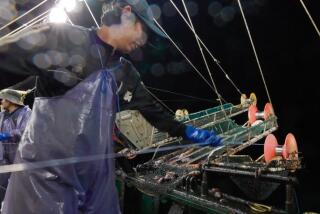CONGRESS : Inspection Program for Fish on Lawmakers’ Front Burner
WASHINGTON — A main entree on Congress’ menu next year is legislation to require federal inspection of fish.
Unlike meat and poultry, which has undergone mandatory inspection for decades, fish is subject only to scattered, voluntary checks.
But with seafood increasingly popular among health-conscious Americans, concern has risen about contamination from polluted waters, pesticide runoff, parasites and disease.
Congress came close to passing a fish-inspection measure this year, but got hung up in “surf-and-turf fights” among competing maritime, agriculture and commerce committees. Those fights must be resolved when the new Congress convenes in January.
The primary issue is whether to set up a broad program in the Agriculture Department--which now oversees meat and poultry--or to start a smaller effort in the Food and Drug Administration focusing mainly on shellfish, the source of most illnesses.
BACKGROUND: U.S. consumption of finned fish and shellfish has increased steadily, amid research showing health benefits. With this growth has come concern, and disagreement, about safety.
For example, Public Voice for Food and Health Policy, a consumer advocacy group, argues that Centers for Disease Control statistics show that the risk of acute illness from seafood is far greater than from meat and poultry. Approximately 65,000 illnesses and 22 deaths occur each year from seafood.
However, Food and Drug Administration officials interpret the same data differently, contending, among other things, that such illnesses are decreasing on a per-pound-consumed basis.
Undisputed is that most seafood-borne illnesses arise from three sources:
--Microbiological pathogens from raw or undercooked molluskan shellfish, especially those taken from sewage-tainted waters;
--Histamine poisoning caused by mishandling mahi mahi, mackerel and certain other fishes;
--A naturally occurring toxin found in certain reef fishes.
A key unknown is the extent to which chemical contamination of seafood may cause cancer. Ongoing research by the National Academy of Sciences may provide a clearer picture.
Currently, seafood inspection is spotty, done at the invitation of processors, packers and others, largely for grading purposes.
The National Fisheries Institute, an industry lobby, advocates strengthened inspection to boost consumer confidence and crack down on fraudulent practices, such as over-breading packaged fish.
“We are almost alone among major fishing nations in not having a strong inspection program,” says Richard Gutting, the institute’s chief lobbyist.
ISSUES: Most hotly debated is whether a big program is either needed or affordable--and which government agency should do the job. Proponents cite the agency’s long experience with meat and poultry, but critics point to problems in those areas.
One proposed approach calls for a broad inspection effort spearheaded by the Agriculture Department at a five-year cost of about $285 million.
An alternative approach backed by the Bush Administration calls mainly for inspection of shellfish, building on a current FDA program at a cost of only $70 million.
Another big issue involves plugging holes in fish inspection plans. For practical reasons, most bills call for spot checks of fish operations instead of the continuous review given meat and poultry. Labor unions and consumer groups want strong protection for whistle-blowing employees who report misconduct when fish inspectors are absent.
OUTLOOK: Some of Congress’ heaviest hitters--including Sen. George J. Mitchell (D-Me.), Sen. Patrick J. Leahy (D-Vt.), Rep. John D. Dingell (D-Mich.) and Rep. Henry A. Waxman (D-Los Angeles)--want stepped-up fish inspection. But they disagree sharply over means. A compromise is likely, but only after fights that may rival the landing of a prize swordfish.
More to Read
Sign up for Essential California
The most important California stories and recommendations in your inbox every morning.
You may occasionally receive promotional content from the Los Angeles Times.










